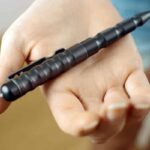Gun enthusiasts, especially the casual shooter and hunter, are pummeled by terminology. Ballistic coefficient, stopping power, and twist rate, as well as internal, external, and terminal ballistics; all are part of firearms nomenclature.
It’s a lot to remember, even for people working in the ammo industry!
Sectional density, for example, is a term you’ll hear from manufacturers and retailers across the country. But what is it and why should you care?
This handy guide will make you better informed about sectional density so you can use this term when selecting your next hunting or target-shooting cartridge.
Understanding Sectional Density: No Physics Degree Required!
What is Sectional Density?
Sectional density is simply a measurement of a bullet’s widest diameter (the caliber) compared to the bullet’s weight. Used to indicate penetration potential, it’s become a standard gauge for rifle bullets, especially hunting rounds.
Measuring Sectional Density
The process for measuring sectional density is actually quite simple. The calculation is bullet weight in pounds divided by the caliber (in inches) squared.
Let’s take, for example, the 180-grain .30-06 Springfield Superformance SST from Hornady. The bullet weight is listed in grains, not pounds, but we can easily calculate the shift. There are 7,000 grains in a pound, so we simply divide the grains (180) by 7,000, which equals 0.0257. (the number strings out more decimals, but we’ll leave it alone!)
Now we need the caliber squared. The .30-06 has a bullet diameter of 0.308 inches, which is 0.095.
Next, we can take 0.0257 and divide it by 0.095. This leaves us with 0.2705263, which Hornady rounds up and lists as 0.271 as the official sectional density for this round.
If you know the bullet weight and caliber, calculating the sectional density is easy. But you don’t have to calculate it on your own; most manufacturers list it in their product information, including the website and brochures.
You can calculate sectional density on your own or simply look at the product information. But what really matters is how sectional density impacts performance and what it means for your purchasing decisions.
To help, here are the most important principles surrounding sectional density…
Principle #1: Sectional Density Impacts Penetration

Why does sectional density matter? Why should you, the rifle or pistol user, be concerned with this little ballistic stat? Because the stat indicates possible penetration.
Other factors, including speed and bullet construction, will have an impact on how deep a bullet penetrates. But, assuming other factors are the same, a bullet with a high SD will create a deeper wound channel than a bullet with a lesser SD.
Principle #2: The Heavier the Bullet, the Higher the Sectional Density
Using the basic math formula, we know that the heavier the bullet, the higher the sectional density. This, of course, assumes that the caliber does not change.
We can easily see this principle in action when we look at products in the same cartridge with different bullet weights. Here’s the sectional density for Hornady .30-06 Springfield products (which all have the same caliber) ranging from 125 to 220 grains. (We selected Hornady because they list sectional density on their rifle product pages.)
|
150 Grain American Whitetail |
|
As the bullet weight increases across these seven .30-06 products, so too does the sectional density. We can assume, therefore, that the 220-grain RN Interlock will have a better chance at deep penetration compared to a 125-grain.
Principle #3: Manufacturers Elongate Bullets to Increase SD
If two bullets have the same diameter and are made from the same material, but one is longer, the longer one will have a heavier weight. It will, therefore, have a larger sectional density.
Manufacturers often use this principle to create hunting bullets that have deeper penetration.
Principle #4: Bullet Shape Does NOT Impact Sectional Density
The bullet shape, outside of the widest diameter section, does not change sectional density. SD only accounts for width (diameter) and weight; no other factors are involved. Two bullets with the same diameter and weight can have vastly different shapes, which gives them different aerodynamics. Yet they still hold the exact same sectional density.
For example, Hornady has 11 55-grain .223 Remington ammo options; all have a sectional density of 0.157. The menu of 55-grain rounds includes ballistic tips, open tip match rounds, full metal jackets, hollow points, and more. Despite the different shapes, because they have the same diameter and weight; they have the same sectional density.
And yet these bullets inevitably have different penetrations because of different bullet construction, materials, and shapes.
Principle #5: Speed Influences Penetration As Well
Sectional density is, at its core, an indication of penetration potential. Other factors impact penetration as well, especially speed. Keep this in mind, as a bullet with high sectional density may not penetrate effectively if it does not have enough speed and force. (It’s important, therefore, to look at velocity and energy stats.)
Sectional Density vs Ballistic Coefficient

Sectional density is often confused with ballistic coefficient. These are two different measurements however, and while both are important to shooters (especially long-range hunters), they should be kept separate.
Ballistic coefficient is a numerical gauge for a bullet’s wind resistance. It takes into account bullet weight, shape, density, and other factors. Ballistic coefficient and sectional density can work together, but they are separate measurements.
Sectional Density: What are the Practical Applications?
After all that, how should you, the casual or not-so-casual firearms enthusiast, think about sectional density? There are essentially two uses where it matters…
Hunting
Sectional density is most important to hunters. While it’s not the only factor, sectional density helps you understand how well a bullet will penetrate into a target. If you are considering two cartridge options for a hunt, you may choose the round with a higher sectional density.
Personal Defense
Although sectional density is less common among handgun discussions, penetration clearly matters for self-defense. Manufacturers don’t often publish sectional density for cartridges like the 9mm Luger or .380 Auto, but it can make a difference in bullet performance. (By the way, if you want to increase sectional density in your handgun loads, simply choose heavier bullets but always use rounds made for self-defense.)
Ready to put sectional density to good use? Order your rifle ammunition from ammoforsale.com today!
Read the full article here











